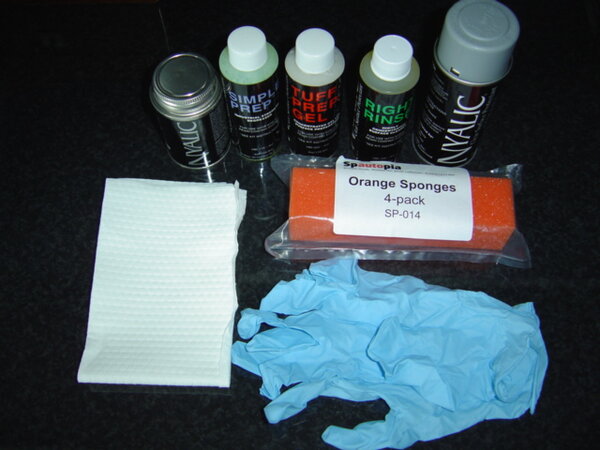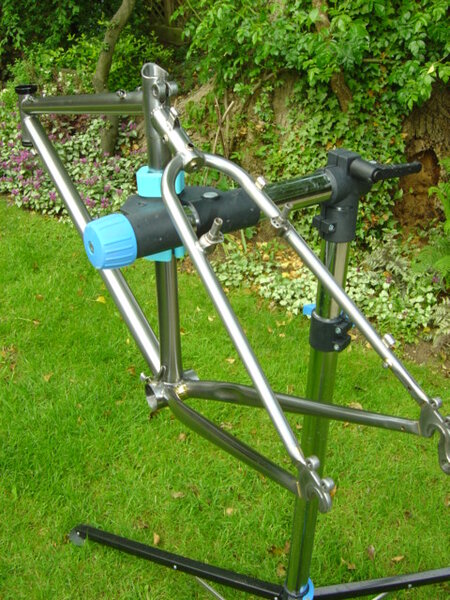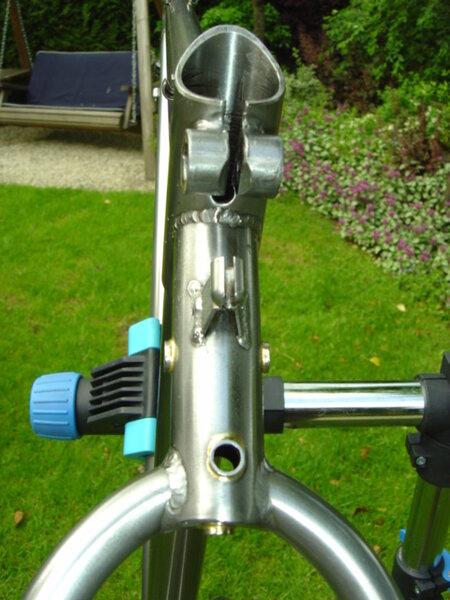You are using an out of date browser. It may not display this or other websites correctly.
You should upgrade or use an alternative browser.
You should upgrade or use an alternative browser.
Hope it doesn't turn out to be a lemon
- Thread starter bj
- Start date
stocko":1j8cvt6b said:I wouldnt want a swap but i have a 19" for sale
As tempting as it would be I am keen not to get too drawn into retrobikes yet and I can't justify having two frames. Went out on my 02 Rock Lobster Ti today - what a joy in comparison.
Initially I will have a go at a swapping the frame, but I suspect I will be left with it - probably put it together for retrorides when it is drier.
Rob
- Feedback
- View
bj":227qpsnn said:stocko":227qpsnn said:I wouldnt want a swap but i have a 19" for sale
As tempting as it would be I am keen not to get too drawn into retrobikes yet and I can't justify having two frames. Went out on my 02 Rock Lobster Ti today - what a joy in comparison.
Initially I will have a go at a swapping the frame, but I suspect I will be left with it - probably put it together for retrorides when it is drier.
Rob
That's right, keep a nice rigid RetroBike so you can pop along to this year Peaks ride (if it is still on the calendar), get some 1.95" 'proper retro' tyres run them at the good pressure of 47PSI. I hear the ride is even better that way.
Love the bare metal look and have therefore been looking for options on clear coat. In general, most references I came across on the internet tended to indicate that commonly used clear coats were not very effective in one way or another.
However, I did come across positive references to a clear coat called Nyalic, albeit not any references to its use on bicycle frames. Although it is relatively expensive I am prepared to give a go.
So for £46 I received the kit shown. Kit contains a cutting paste, degreaser, rinser, and the Nyalic coat (one aerosol, one can). After reading the instructions I have had to purchase some xylene to remove traces of silicone spray that I had put on the frame.
Frustratingly, the coat has to be applied in temperatures above 12C. I only have an unheated detached garage as a work space so that scuppers the project until Spring at least ... unless there is anyone in the Rugby area that can offer me access to a warmer workspace!!
Rob
However, I did come across positive references to a clear coat called Nyalic, albeit not any references to its use on bicycle frames. Although it is relatively expensive I am prepared to give a go.
So for £46 I received the kit shown. Kit contains a cutting paste, degreaser, rinser, and the Nyalic coat (one aerosol, one can). After reading the instructions I have had to purchase some xylene to remove traces of silicone spray that I had put on the frame.
Frustratingly, the coat has to be applied in temperatures above 12C. I only have an unheated detached garage as a work space so that scuppers the project until Spring at least ... unless there is anyone in the Rugby area that can offer me access to a warmer workspace!!
Rob
Attachments
Still waiting for warmer weather before I start this. I want to give this the best possible chance, and will try to stick to the application instructions. The primary hold up is waiting for the ambient temperature to rise above 12C for a while. I would have had this finished in any other normal Spring, but this year my unheated and detached garage is staying consistently well below 12C (cave effect), even on the few occasions we have had some warmer weather.
Frame is prepared and stares at me imploringly every time I go in the garage.
I intend to update as and when it happens. Long range forecast (couple of weeks) looks to remain too cold.
Rob
Frame is prepared and stares at me imploringly every time I go in the garage.
I intend to update as and when it happens. Long range forecast (couple of weeks) looks to remain too cold.
Rob
was8v":3oi4vh89 said:Could have had it clear powder coated cheaper than that and powder is extremely durable!
Was one of the options that I considered. However, experience from others err on the side that the clear coat is porous to water causing the steel to 'spider' rust after a year or so. In addition, there appears to be concern that clear coat does not 'key' well to polished steel, causing it to flake off.
Reports to date are very favourable to Nyalic, in particular it appears to be holding up well on marine craft - a pretty tough environment. Haven't found any reports of it having been used on polished steel bikes frames yet, so I am prepared to be the one to try.
To be a fair test I do need to apply it as per instructions though.
1) Needs to be applied when ambient temp above 12C, but not in direct sunlight.
2) Frame has to be spotlessly clean (free from wax, oils and silicons) hence the cleaning regime ( xylene, prep degreaser, and rinse agent).
The Nyalic itself is apparently very easy to apply (has the consistency of water). Applied by spray or sponge. Drys in 15 minutes, cures after 3 days, full hardness after about 30 days. The coat is very thin, and for this reason scratches disappear once touched up.
The sole importer was very approachable when I rang to discuss the product. They have sent me a spray version and a 'sponge on' version for me to try.
Rob
Well finally got around to applying the Nylic clear coat today.
1) The Nyalic kit came with a 'rubbing gel' and pad. However, this had little effect at polishing the steel. I resorted to a very fine artificial rubbing wool followed by 'autoglym' polishing cream. This brought the frame up to a nice polish, yet retained some patina.
2) Wiped the frame down with 'Xylene' to remove any traces of silicon.
3) Washed the frame down with detergent and rinse provided with the kit.
4) Washed the frame down with just the rinse.
5) Sprayed off with water.
6) Dried frame off immediately.
7) Applied the Nyalic. First used a fine paintbrush to apply to the fiddly bits ( cable bosses, etc). Secondly applied a layer using the provided sponge. Thirdly sprayed using the provided spray can.
The Nyalic is very thin and any runs can easily be brushed out without causing any unsightly brush marks. It dries within 15 mins and can have a second coat applied before or after it has dried. It very good at self levelling - so if a loose brush hair is removed from a dried patch, a quick spray heals the coat.
Overall the Nylic was very easy to apply - the key to success is to make sure the frame is spotlessly free from contaminants. Although it feels completely dry after 15mins, it has to be left for 3 days to cure and 30 days to fully harden.
So over the next few weeks I shall rebuild the bike and get it out for a spin. Interested to see how it responds to being cleaned. The instructions suggest it be kept free of silicon or cleaners such as 'Mucoff'.
At this stage I am very pleased with the finish. Definitely the right choice to get one spray and one pot of Nyalic. There is enough to do two bikes.
Rob
1) The Nyalic kit came with a 'rubbing gel' and pad. However, this had little effect at polishing the steel. I resorted to a very fine artificial rubbing wool followed by 'autoglym' polishing cream. This brought the frame up to a nice polish, yet retained some patina.
2) Wiped the frame down with 'Xylene' to remove any traces of silicon.
3) Washed the frame down with detergent and rinse provided with the kit.
4) Washed the frame down with just the rinse.
5) Sprayed off with water.
6) Dried frame off immediately.
7) Applied the Nyalic. First used a fine paintbrush to apply to the fiddly bits ( cable bosses, etc). Secondly applied a layer using the provided sponge. Thirdly sprayed using the provided spray can.
The Nyalic is very thin and any runs can easily be brushed out without causing any unsightly brush marks. It dries within 15 mins and can have a second coat applied before or after it has dried. It very good at self levelling - so if a loose brush hair is removed from a dried patch, a quick spray heals the coat.
Overall the Nylic was very easy to apply - the key to success is to make sure the frame is spotlessly free from contaminants. Although it feels completely dry after 15mins, it has to be left for 3 days to cure and 30 days to fully harden.
So over the next few weeks I shall rebuild the bike and get it out for a spin. Interested to see how it responds to being cleaned. The instructions suggest it be kept free of silicon or cleaners such as 'Mucoff'.
At this stage I am very pleased with the finish. Definitely the right choice to get one spray and one pot of Nyalic. There is enough to do two bikes.
Rob
Attachments
Similar threads
- Replies
- 44
- Views
- 9K
- Replies
- 2
- Views
- 884


